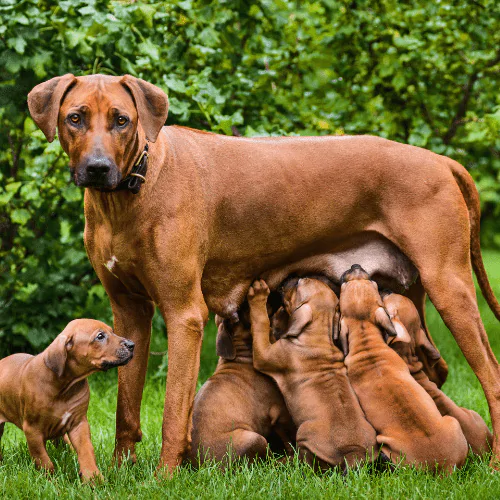
Dog pregnancy: What you need to know

Philippa Short
22 December 2022 | 14 minutes read
Are you thinking about breeding from your female pup? Or simply curious as to how it all works? Read on to learn all about dog pregnancy from expert canine behaviourist Philippa Short.
- How does a dog get pregnant?
> How long after mating can you tell a dog is pregnant - The dog gestation period
> Dog pregnancy signs and symptoms
> When can you feel the puppies move in a pregnant dog - Caring for your pregnant dog
> Exercising a pregnant dog
> Feeding a pregnant dog - What to expect from the last two weeks of dog pregnancy
> How to prepare for your pregnant dog’s labour
> What are the first signs of a dog going into labour? - The different stages of active dog labour
> First stage of dog labour
> Second stage of dog labour
> Helping your pregnant dog during birth
> Recording and monitoring the puppies - What to do if your dog is in distress during birth
- What to do after your pregnant dog has finished giving birth
> Toileting after your dog has given birth
> Feeding after your dog has given birth
> Bathing after your dog has given birth
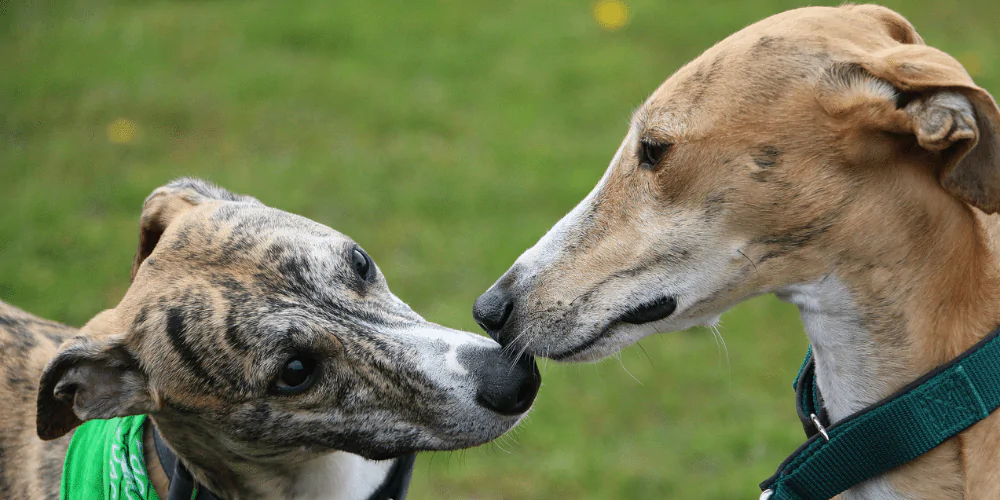
How does a dog get pregnant?
For a female pup to get pregnant:
- She will stand with her tail swung to the side and the male dog will enter her
- Two to three matings are recommended as long as the female is still standing (most breeders will put a stud dog on a female twice)
- If your canine has had a good tie and her body tells her she’s done, she won’t let the male try again
- Don’t attempt another mating if she isn’t willing, especially if she was enthusiastic about mating previously
Female dogs can get pregnant once they’ve had their first season. They come into season up to twice a year for around 21 days each time, though a cycle can last for up to 28 days.
Once the dog’s vulva is swollen and her bleeding turns into a light discharge, she’s ready to receive males. This is normally around days nine to 16 of the cycle but can be as early as day three.
For a full breakdown of dog periods and seasons, check out our handy guide on the dog heat cycle.
If you want to breed from your female dog then it’s ideal to get a progesterone test done. The test tells you (within a 24 hour window) when she has the highest chance of conceiving. This is especially helpful for females in their first season as ovulation can be delayed.
> How long after mating can you tell a dog is pregnant
A reliable way to tell if your dog is pregnant is via a blood test or scan.
You can take your girl for a blood test three weeks after (and for a scan four weeks after) mating.
Most people will go to their vets but you can also visit a canine midwife for these check-ups.
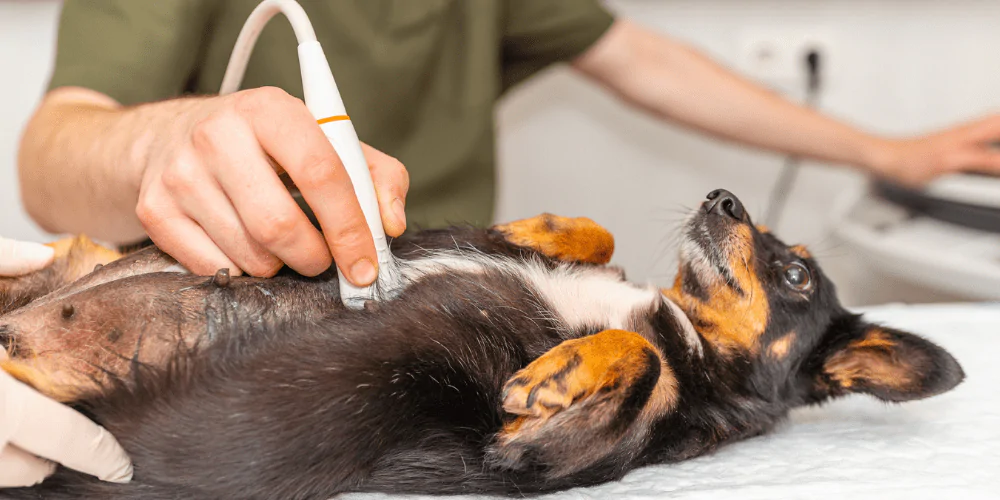
The dog gestation period
The average dog gestation period is 63 days but can last between 59 and 65 days.
Call a vet if your female’s puppies start to come earlier than 59 days. This is because their lungs may not be fully developed and there may be other issues.
Your pooch should also see a vet if she is running six days or more past her due date. She may end up needing a c-section if the puppies grow too big.
> Dog pregnancy signs and symptoms
So, how do you know if your dog is pregnant?
Breed and hormones play a big part in what pregnancy symptoms your girl may start to show. These include:
- Morning sickness (retching up little mouthfuls a few times a day) – this is normal for the week after mating but can last throughout the pregnancy
- Going off or getting very fussy about food
- Getting a ferocious appetite (if they don’t suffer from morning sickness)
- Enlarging nipples – these can start to become elongated and protrude, widening and getting a milk line in the last week of pregnancy
- Getting emotionally sensitive and needing to be with you more than normal, including showing signs of separation anxiety
- Wanting to explore the house and garden to find nesting places
Nesting behaviours can be stronger in some female dogs, so be aware if they start shredding and destroying things – and don’t get cross. They’re not being destructive and disobedient for the sake of it, they’re simply trying to make a nest. The same is true for the garden. Terriers and Collies will dig holes outside to create a birthing spot.
Most importantly, watch your pregnant pup for red flag symptoms. If she shows any of the following, go to your vet immediately:
- Looking like she’s in distress
- Crying
- Vomiting and diarrhoea (not just loose stools)
- Any discharge from the vulva
> When can you feel the puppies move in a pregnant dog
The time when you can feel the puppies move inside a pregnant dog varies with each breed. For some, it will be obvious as their belly pops out and you can see the pups moving under the skin.
But it can be harder to feel all of the puppies with some dogs. This really depends on how many are in the litter and where they’re sitting in the mum’s uterine horn. An ultrasound can’t see past the bone, so it might not catch them all on the monitor.
If you’re ever in doubt about the number of puppies your girl is carrying, visit your vet.
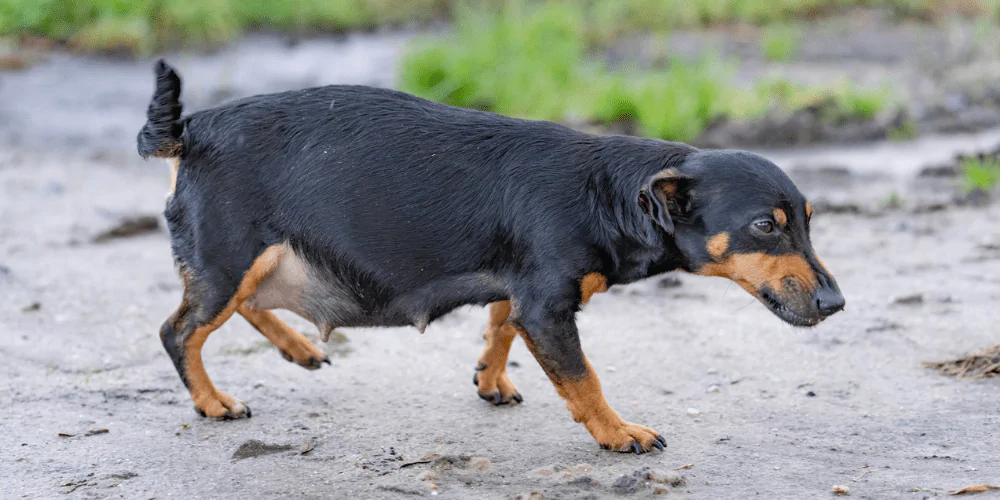
Caring for your pregnant dog
> Exercising a pregnant dog
How you exercise your pregnant pooch depends on her breed. In her second month of pregnancy (from 30 days onwards), you don’t want any boisterous play with other dogs. This is because there’s a risk of collision with her belly.
But being careful doesn’t mean wrapping her up in cotton and confining her to the house!
Let your pooch take the lead (pun intended) on exercise. Try to stay away from heavily dog-populated areas and hire an exclusive dog-walking field instead. She can run and stretch safely without needing to be protective over her stomach.
> Feeding a pregnant dog
When it comes to feeding your pregnant girl:
- Make sure you give her a balanced and power-packed diet.
- Be very careful about feeding her extra volume as you don’t want the puppies to grow too big, especially with a smaller litter.
- You want your pooch to be nutritionally supported but not over-fed as more weight puts extra strain on her body.
- As she gets bigger (especially if she’s carrying a lot of pups), she won’t have much room in her stomach to eat or digest food. So look at breaking up her food allowance into smaller amounts and feed frequently throughout the day.
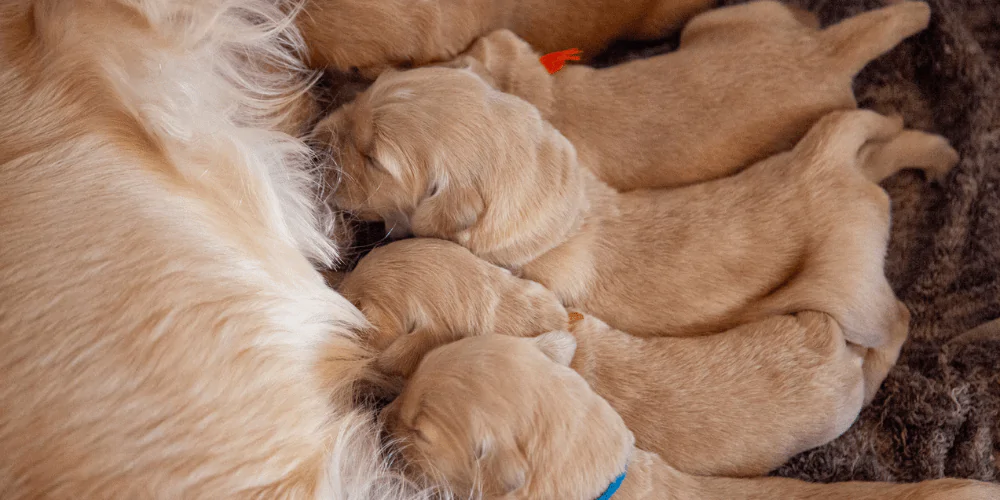
What to expect from the last two weeks of dog pregnancy
> How to prepare for your pregnant dog’s labour
You’ll want to set up a whelping box at least two weeks before your girl’s due date. This is a four-sided box with little rails. The pups can then move out of the way of mum without getting trapped. The box should be:
- Appropriate to your dog’s breed size – too big or too small and the rails will either trap the puppies or move them too far away from mum.
- Placed somewhere safe and quiet for calm birthing and nursing – your female pup will nest in many places, but you’ll need to pick her whelping spot. It shouldn’t be in the main thoroughfare of the house.
- Placed somewhere that can be temperature controlled – you should be able to adjust the space to be warm or cool enough, which is why areas like conservatories are a bad idea.
- Lined with puppy pads and then a vet bed – be careful with using lots of loose blankets as mum can accidentally bury the puppies.
Many pet owners choose their bedroom as the whelping area of the house. You can use calming sprays and music to help your pregnant pooch feel her babies will be safe.
Once the whelping space is set up, the only people allowed in are those in your girl’s circle of trust. Others can then go in once the puppies are three weeks old.
Other things to prepare:
- If you know your dog is having a big litter, make sure you know which vet has an emergency overnight service.
- Speak to your vet ahead of time to see who can do a C-section if needed.
- Bring in a friend who can be on standby to help you get mum and puppies in the car for an emergency visit.
- Have your emergency/support numbers to hand – vet, friends, family.
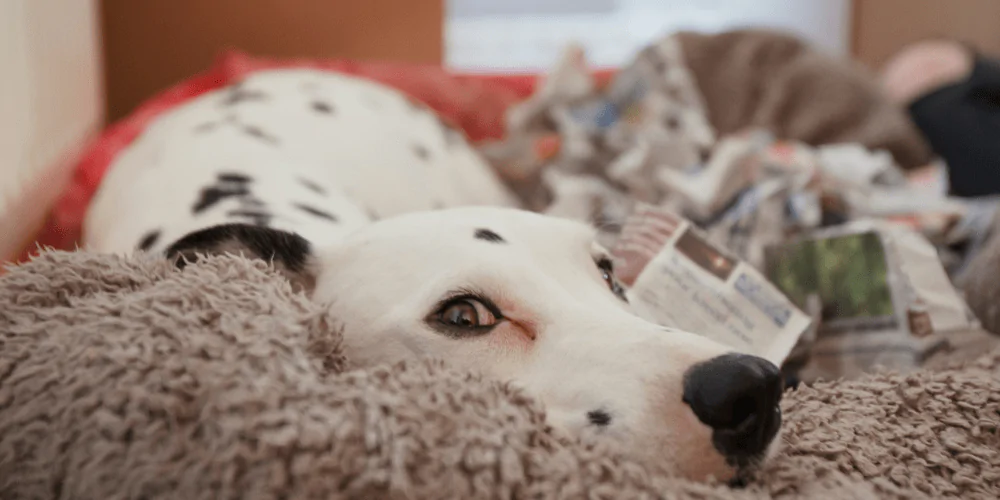
> What are the first signs of a dog going into labour?
So, how do you know if your dog is getting closer to labour? In her last week of pregnancy (and depending on the size of her litter) she can show the following signs:
- General increased discomfort, but especially around her vulva
- Needing to go to the toilet more regularly and constantly asking to go out – she may have accidents if you don’t respond, so keep a close eye out
- Excess pooing
- Going off her food, as there’s no room in her stomach to eat unless she’s getting tiny meals
- Guarding spaces where they want to give birth from other dogs
- Ramping up nesting behaviour such as scratching, digging, stashing food, and burying chews around the house
- Having an obvious drop in temperature (around 48 hours before she’s due to whelp)
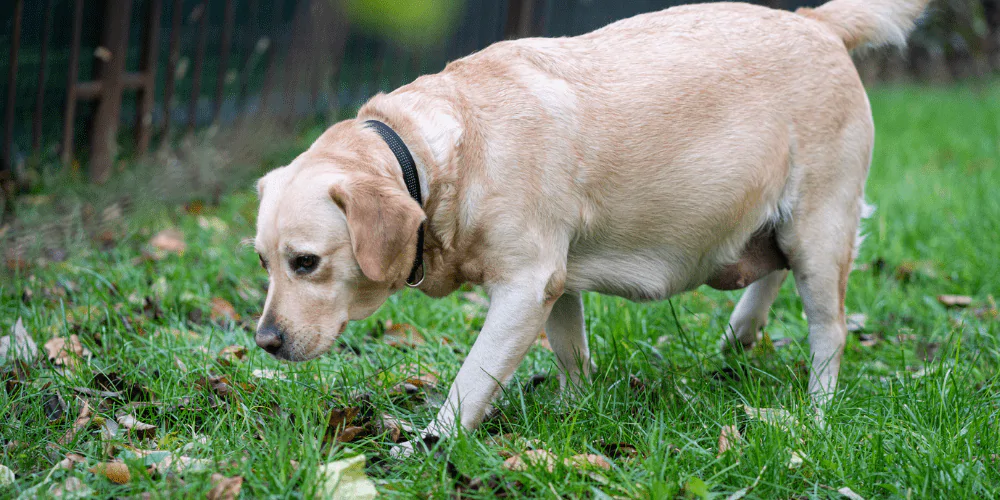
The different stages of active dog labour
> First stage of dog labour
During the first stages of labour, your pregnant pup will be:
- Actively digging and nesting
- Looking uncomfortable
- Shifting between lying down, sitting, and standing up
- Looking at her belly
- Excessively panting
- Some dogs may vomit up their last meal (if their body can’t digest it, they’ll simply empty it out)
> Second stage of dog labour
During the second stage of labour, your pooch will:
- Actively start to push – this can be standing or lying down, your girl will decide what works for her
- Be visibly straining – some do this quietly, while others can be vocal (for example, Huskies and Whippets)
- Have contractions on the sides of her belly
Puppies normally come out head first, often still in their amniotic sack, and your dog will be aware they have come through. She may half sit up and lick as the puppy is coming out, or wait until the pup is fully out.
- Sometimes the puppy will arrive still in the sack and you’ll see the umbilical cord come out at the same time as the placenta
- Sometimes the puppy will come out with the cord still attached, but the placenta is pushed out later
- The key thing is to make sure you’ve counted one placenta for each pup
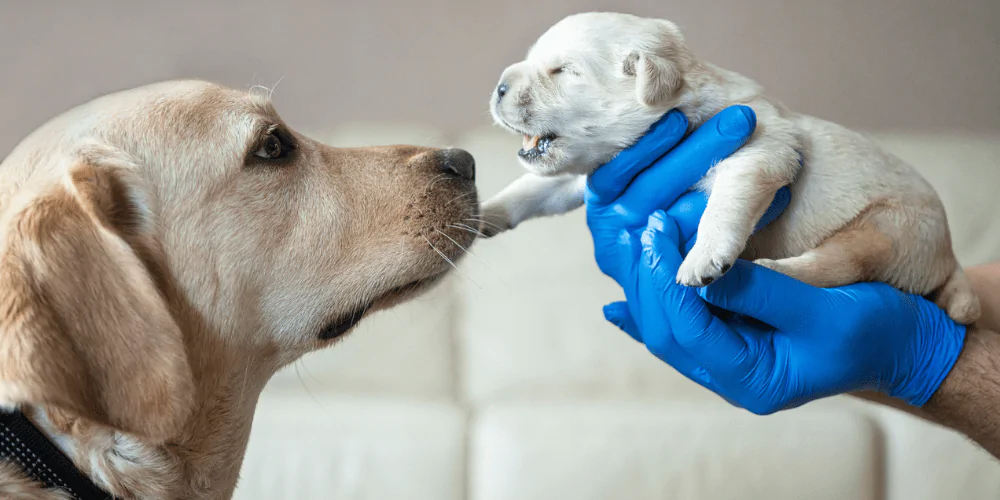
> Helping your pregnant dog during birth
Breaking the puppy’s sack
As soon as the puppy is pushed out, the sack needs to be broken.
Most mums will do this themselves, but if you see her struggling (especially if she’s a first-time mum), you can give her a hand.
Use your fingernails to gently tear the sac open so the puppy is breathing.
Dog mums will naturally chew through the umbilical cords themselves and often want to eat the placenta.
Stimulating the puppy
The next step is for your dog to stimulate her puppies by licking them constantly from head to foot. This is part of their bonding process so if she’s getting on well, just be a quiet observer and give gentle praise.
Only step in to help if you can tell she’s struggling or the puppy looks lifeless (they should be squeaking and fidgeting). For example, the puppies may be coming so quickly that she doesn’t have enough time to stimulate them properly.
- Use a warm, clean, fluffy hand towel to gently rub and stimulate the puppy
- If you think the puppy has excess mucus in their lungs, holding them upside down can help with natural draining
- Dopram V drops can also encourage the puppy to take a deep breath of air and cough out mucus
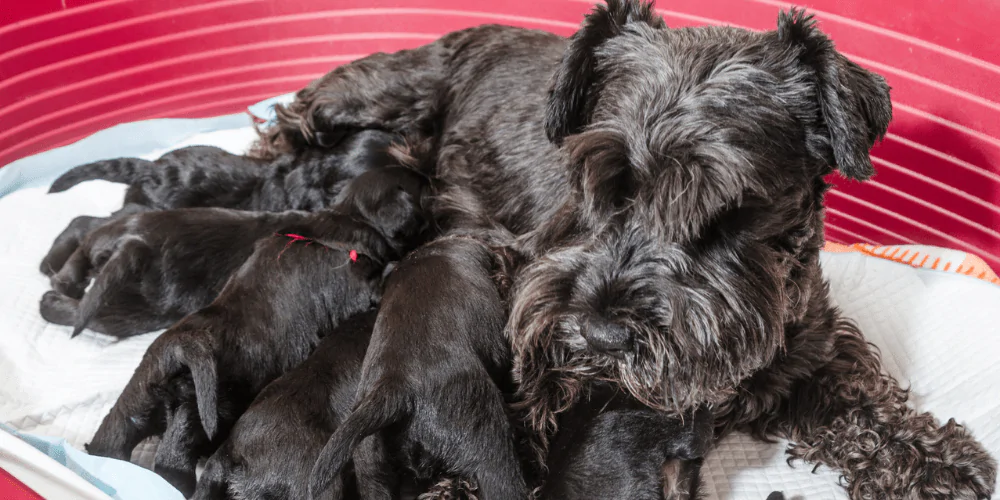
> Recording and monitoring the puppies
Identifying and recording the puppies is really important for following their growth and checking for disabilities or internal problems.
You’ll then want to weigh them every few days to make sure they’re latching and feeding properly.
To record the puppies:
- When they first come out – depending on breed, write down their sex, the colour/pattern of their fur, and their order of birth on a notepad.
- After they’ve been washed by mum – you can put little dabs of non-toxic nail polish on the tail or back of the feet so they’re easier to identify.
- After mum has fully finished birthing and cleaning – quietly take each puppy and weigh them on kitchen scales close to mum.
- Quietly note that all their body parts look good. For example, they have all four feet and toes, whether they have a kink in the tail (depending on breed).
- Look out for a cleft palate (the front lips will be parted with a gap). You may also need to gently open the mouth and look for a split in the roof.
The important things to remember with recording the puppies:
- Do the checks quickly and quietly, returning the puppies back to mum as soon as possible
- Don’t leave the room – everything should be done right there and then in full view of mum so she’s comfortable
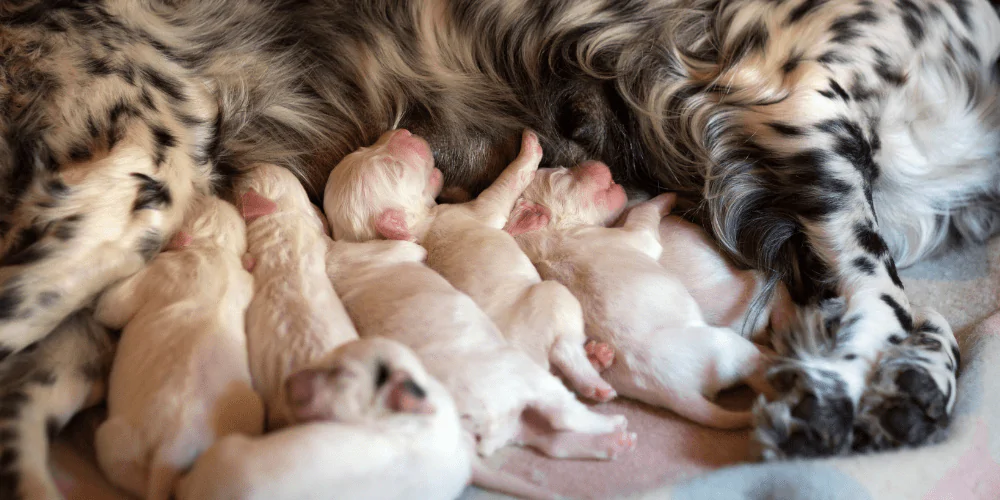
What to do if your dog is in distress during birth
If you’re worried about your dog during their labour, call your vet. They may either come out to you or ask you to bring her into the clinic.
You may need vet help if your girl:
- Is showing any signs of distress at any point during whelping
- Is straining, her waters break, and the puppy doesn’t arrive within two hours
- Has a putrid smell – this is a sign that a puppy has died and increases the risk of infection
Not all puppies will survive – and this is very normal for dog pregnancies. There’s also a risk that mum won’t make it through, so it’s something to think about when you’re looking at breeding.
Things can go wrong quickly, so keep a close eye on your female pup and make sure you’ve got an emergency vet line.
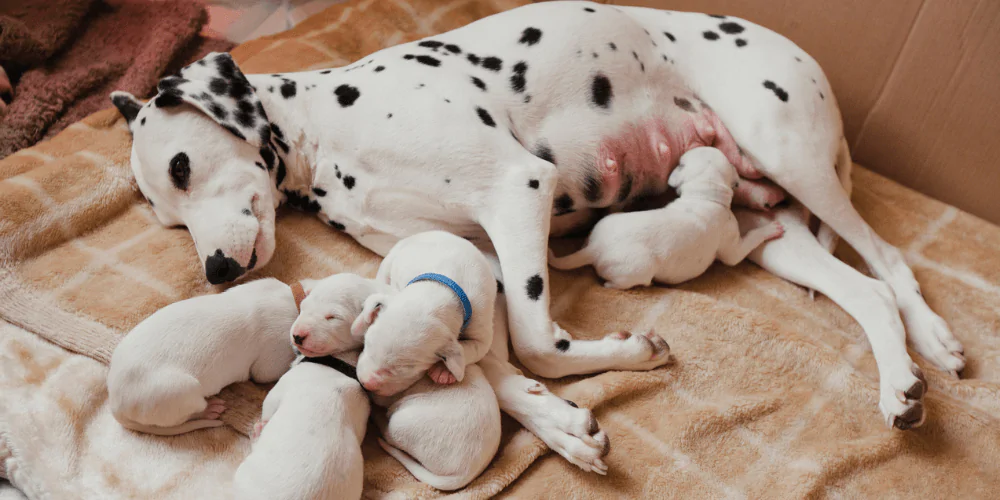
What to do after your pregnant dog has finished giving birth
You’ll know your female pup has finished giving birth as she’ll become much calmer.
Some mums will have:
- Cleaned the entire vet bed
- Have eaten the afterbirth
- Licked the puppies clean until they’re shiny
Other mums who’ve just had their first or a big litter may be a little more overwhelmed. So you might need to help her by:
- Putting down another piece of vet bed
- Quietly and gently supporting her getting into a comfortable lying position
- Bringing the puppies over to latch
- Reassuring and gently praising her if she looks like she’s fidgeting or struggling
Remember, you’re helping but not taking over. If she’s coping well, leave her to nurse the puppies.
Don’t let any other animals in the house near the puppies for the first two or three days. Only when mum is happy can they get close.
You’ll want to stay with her for at least the first 48 hours, especially if it’s your dog’s first litter. Yep, this includes sleeping next to the whelping box! You’re making sure she’s emotionally comfortable before you leave her.
Most importantly, don’t do anything with the puppies when mum isn’t there. This will break your trust with her and she won’t want to leave them alone again.
> Toileting after your dog has given birth
- If she wants to go outside to wee or poo, make sure she always has immediate access back to the puppies.
- If she wants to wee next to the whelping box, let her do it, especially if she’s a new mum. It’s her way of saying she can’t leave the puppies right now.
- Want to encourage her to leave the puppies and go to the toilet? You need to convince her that no one can get to them.
> Feeding after your dog has given birth
- Always have fresh water right next to the box so your dog doesn’t have to leave her puppies to get a drink.
- For her first meal, try and stay away from stodgy food as she’ll be tired and sore. Warm goats milk with honey is a lighter option and gives her a boost of energy.
- For the first three or four days, give her lots of little meals to make it easier on her stomach.
> Bathing after your dog has given birth
- On the second or third day after birth, you can give your pooch’s behind a little wash to clean up.
- When she’s ready to be bathed, think about what facilities you have in the house. You don’t want to be lifting a big heavy dog into a slippery bath.
- A warm outdoor or walk-in shower with a non-slip mat is ideal as this is safer and more comfortable for your girl.
Look after your top canine throughout her life with Petsure dog insurance.


